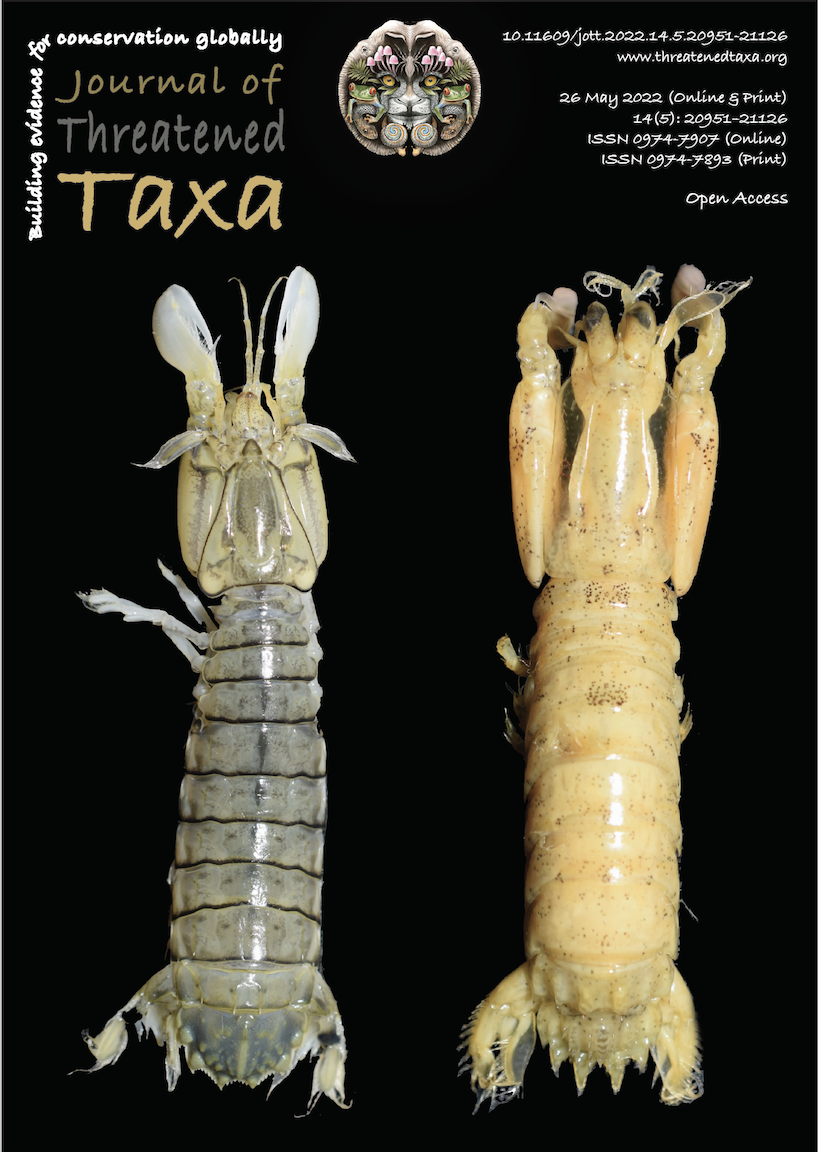Nectar robbing by sunbirds on the flowers of Morinda pubescens J.E. Smith (Rubiaceae)
Main Article Content
Abstract
Morinda pubescens is a dry season blooming tree species. The flowers are hermaphroditic distylous, fragrant and nectariferous. Thrips use floral buds for breeding and flowers for food. Sunbirds, Nectarinia asiatica and N. zeylonica pick up thrips from the flowers by probing the flowers legitimately and collect nectar illegitimately by making a puncture/slit at the base of the corolla tube from outside. The illegitimate nectar robbing by sunbirds on the flowers of M. pubescens relates to primary robbing. The study indicates that M. pubescens flowers are an important source of thrips as insect food and nectar as instant drink for sunbirds during dry season in the deciduous forest ecosystem.
Article Details

This work is licensed under a Creative Commons Attribution 4.0 International License.
Authors own the copyright to the articles published in JoTT. This is indicated explicitly in each publication. The authors grant permission to the publisher Wildlife Information Liaison Development (WILD) Society to publish the article in the Journal of Threatened Taxa. The authors recognize WILD as the original publisher, and to sell hard copies of the Journal and article to any buyer. JoTT is registered under the Creative Commons Attribution 4.0 International License (CC BY), which allows authors to retain copyright ownership. Under this license the authors allow anyone to download, cite, use the data, modify, reprint, copy and distribute provided the authors and source of publication are credited through appropriate citations (e.g., Son et al. (2016). Bats (Mammalia: Chiroptera) of the southeastern Truong Son Mountains, Quang Ngai Province, Vietnam. Journal of Threatened Taxa 8(7): 8953–8969. https://doi.org/10.11609/jott.2785.8.7.8953-8969). Users of the data do not require specific permission from the authors or the publisher.
References
Arya, L., R.K. Narayanan, M. Verma, M., A.K. Singh & V. Gupta (2014). Genetic diversity and population structure analyses of Morinda tomentosa Heyne, with neutral and gene based markers. Genetic Resources and Crop Evolution 61: 1469–1479. https://doi.org/10.1007/s10722-014-0168-4
Bremer, B. & J.F. Manen (2000). Phylogeny and classification of the subfamily Rubioideae (Rubiaceae). Plant Systematics and Evolution 225: 43–72. https://doi.org/10.1007/BF00985458
Irwin, R.E. & J.E. Maloof (2002). Variation in nectar robbing over time, space, and species. Oecologia 133: 525–533. https://doi.org/10.1007/s00442-002-1060-z
Irwin, R.E., J.L. Bronstein, J.S. Manson & L. Richardson (2010). Nectar robbing: ecological and evolutionary perspectives. Annual Review of Ecology and Systematics 41: 271–292. https://doi.org/10.1146/annurev.ecolsys.110308.120330
Kesonbuaa, W. & P. Chantaranothai (2013). The genus Morinda (Rubiaceae) in Thailand. ScienceAsia 39: 331–339. https://doi.org/10.2306/scienceasia1513-1874.2013.39.331
Maloof, J.E. & D.W. Inouye (2000). Are nectar robbers cheaters or mutualists? Ecology 81: 2651–2661. https://doi.org/10.2307/177331
Navarro, L. (2001). Reproductive biology and effect of nectar robbing on fruit production in Macleania bullata (Ericaceae). Plant Ecology 152: 59–65. https://doi.org/10.1023/A:101146352039

